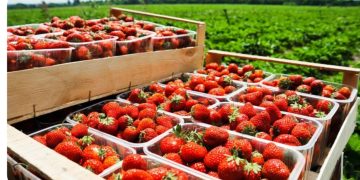According to a report from IQ by Intel, food cold chain technologies such as computer vision, artificial intelligence and data analysis are tracking fresh produce from the farm to trucks to stores in an effort to reduce food waste.
The moment a strawberry is picked in the field, it begins to decay. From there, it’s a race to deliver it fresh to the consumer. This was easier a few generations ago when most people worked in agriculture and lived close to food production. Distributing food today is more complex as more consumers rely on supermarkets to get food.
Today, delivery of perishable food relies on what’s known as the food cold chain. This vastly complex distribution of food from farm to fork relies on maximizing the quality and longevity of crops.
Adding artificial intelligence (AI), computer vision and cloud computing to food inspections, trucking and refrigeration is bringing efficiency to food logistics.
“The goal is straightforward and pretty simple,” said Dan Hodgson, a partner with Linn Grove Ventures, a Fargo, North Dakota-based agricultural venture capital group. “The environment around that crop, whether it’s on a truck or a plane, has to be just right all through its journey — it’s in the journey where it gets complex.”
Keeping strawberries at the right temperature, humidity and airflow is only one problem. The fruit also needs to be delivered to the right markets in the right amounts on the right days, where it will actually be purchased.
“Managing quality means managing many different people at each stage of distribution and the different speeds it happens at,” Hodgson added.
“Sensors and cloud computing are helping to really get handle on it.”
That’s where a smartphone app for food inspectors can help, according to AgShift, an agtech AI firm in Santa Clara, California. The company uses algorithms to assist with food inspection at different stages of distribution.
“Let’s say we’re looking at 20 strawberries,” said Miku Jha, CEO of AgShift. “Two different inspectors might come back with two different results. What the technology does is to help those inspectors make more objective observations.”
Photographing produce and sending the pics to the cloud for analysis allows AgShift to leverage computer vision and deep learning algorithms to assess the quality of produce each time it’s inspected on its journey.
“Digitization and automation really make an impact on efficiency,” Jha said.
More accurate inspections give sellers better insights into the shelf life and pricing of specific shipments of produce. Knowing the quality of each box of strawberries — and other perishables — serves as a baseline for many kinds of decisions in the food cold chain.
Tech Before Planting
The food supply chain starts well before seeds are even planted in the ground. Produce farmers literally map out every inch of field with GPS technology, already knowing what factors could affect planned crops.
































